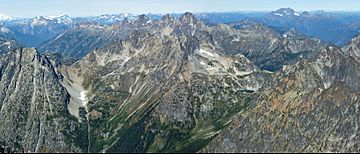Mount Arriva facts for kids
Quick facts for kids Mount Arriva |
|
|---|---|

Arriva and Ragged Ridge from Black Peak
|
|
| Highest point | |
| Elevation | 8,215 ft (2,504 m) |
| Prominence | 1,215 ft (370 m) |
| Isolation | 2.3 mi (3.7 km) |
| Parent peak | Black Peak 8,975 ft |
| Geography | |
| Location | North Cascades National Park Skagit County, Washington, United States |
| Parent range | North Cascades |
| Topo map | USGS Mount Arriva |
| Climbing | |
| First ascent | 1966 |
| Easiest route | class 3 scrambling |
Mount Arriva is a tall mountain in the North Cascades range. It stands 8,215 ft (2,500 m) high in the state of Washington, USA. You can find it inside North Cascades National Park. The mountain sits right on the border between Chelan County and Skagit County.
Even though it's not far from Easy Pass or the North Cascades Highway, you can't see Mount Arriva from those spots. The closest taller mountain is Black Peak. It is about 2.57 mi (4.14 km) to the southeast.
Mount Arriva actually has two main tops. The East Peak was first climbed in 1940. Fred Beckey and his friends Jim Crooks and Ed Kennedy made that first climb. The true highest point, the West Peak, was first climbed much later. Joe and Joan Firey, along with John and Irene Meulemans, reached the summit on July 6, 1966.
Weather and Climate Around Mount Arriva
Mount Arriva is in a place with a "marine west coast" climate. This means it gets a lot of moisture from the ocean. This type of climate helps a small glacier stay on the mountain's northeast side.
Most of the weather comes from the Pacific Ocean. It moves northeast towards the Cascade Mountains. When these weather systems hit the tall peaks of the Cascades, they are forced to rise. This makes them drop their moisture as rain or snow. This process is called Orographic lift.
Because of this, the western side of the North Cascades gets a lot of rain and snow. This is especially true in winter. The climate here is mild, so temperatures rarely go below 0 °F (−18 °C) or above 80 °F (27 °C).
In winter, it's often cloudy. But in summer, high pressure systems over the Pacific Ocean bring clear skies. The snow here tends to be wet and heavy. This can create a high risk of avalanches. Water from Mount Arriva flows into the Stehekin and Skagit Rivers.
How Mount Arriva Was Formed (Geology)
The North Cascades mountains have very rugged shapes. They feature sharp peaks, rocky ridges, and deep valleys carved by glaciers. These amazing shapes and big changes in height were created by geological events over millions of years. These changes also led to different climates and types of plants in the area.
The Cascade Range started forming millions of years ago, during the late Eocene Epoch. At that time, the North American Plate was slowly moving over the Pacific Plate. This movement caused a lot of volcanic activity.
Also, small pieces of the Earth's crust, called terranes, joined together. These pieces of both ocean and continental crust helped build the North Cascades about 50 million years ago.
Over two million years ago, during the Pleistocene period, glaciers played a huge role. They moved forward and backward many times. As they moved, they scraped and shaped the land. They left behind piles of rock and debris. The "U"-shaped valleys you see today were carved by these glaciers.
The main forces that created the tall peaks and deep valleys of the North Cascades were uplift (when land rises) and faulting (when cracks form in the Earth's crust). These, combined with the action of glaciers, shaped the landscape we see today.



